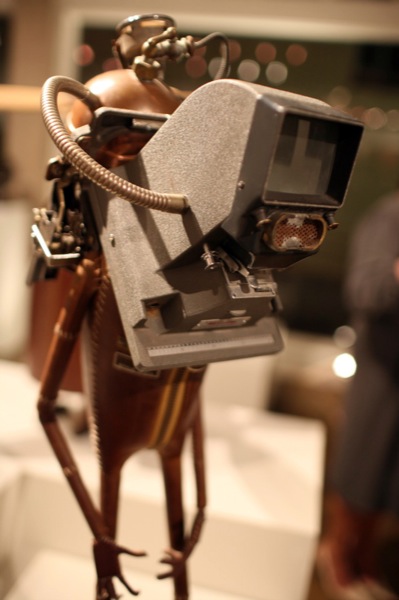Saturday night marked the opening reception of the Fantastic Contraption exhibit I’ve been blustering about. Curated by Device Gallery owners Greg and Amy Brotherton, this show focuses on man, machine and the fusion of the two.

A very happy Greg Brotherton with his work.You may have seen Greg on Coilhouse before – read Nadya’s writeup here.
Device is nestled comfortably among dozens of galleries near the ocean. The touristy neighborhood is full of art, boutiques and eateries but there’s nothing quite like Device here! The gallery has plenty going for it besides its location, too – its spacious interior is overflowing with art I’d only dreamed of seeing in one place. Where else can you see H.R. Giger hanging alongside the huge canvases of Eduard Anikonov, wander beneath the shadow of Brotherton‘s Mercury 5000 and hover over the several enhanced insects on display before getting lost in Halleux’s menagerie of characters! I even spied work by Kazuhiko Nakamura of Mechanical Mirage – one of my earliest mentions here on Coilhouse. The exhibit has a distinct zeitgeist feel, this much I tell you with complete certainty.

Sculpture by Stephane Halleux
After some time spent exploring I had the pleasure of chatting with Greg and Amy along with Nemo Gould and Stephane Halleux, whose work is approximately 98% more impressive in person. I also took tons of photos some of which are below the jump while the rest are being uploaded here, as time allows.
It will be interesting to see how a space like this does among galleries specializing in friendly still life, idyllic beach scenes and the like. Considering Saturday’s turnout, my prognosis is “just fine”. Fantastic Contraption is Device Gallery’s inaugural show and runs through September 2. Go now.
Posted by Zoetica Ebb on July 22nd, 2008
Filed under Art, Culture, Cyberpunk, Events, Sculpture, Uniform | Comments (10)

Christopher Conte is a Norwegian artist and designer of prosthetic limbs. He studied in the States and his prowess in both art and science has led him to create some of my favorite biomechanical sculptures to date. One of the outstanding aspects of Christopher’s work is how functional it looks. This is the sort of technology I imagine wandering the face of uncharted planets or carrying out assorted tasks here on Earth. Clean lines, efficient design that looks straight off some futuristic lab’s assembly line and a keen understanding of mechanics sets Conte’s work apart. I can’t wait to see it up close at the show!

A bit about Christopher Conte from his website:
After earning a BFA from Pratt Institute, he entered the prosthetics field and began making artificial limbs for amputees in New York. Combining an abiding love for sculpture, medical science and biomechanics, the field enables Chris to apply his natural talents to help others in less fortunate situations, which he still does to this day. All along, creating sculpture never escaped his deepest passion. In 2007, Chris began offering these unique pieces for sale to the public for the first time.
Posted by Zoetica Ebb on July 5th, 2008
Filed under Art, Cyberpunk, Events, Flora & Fauna, Sculpture, Technology | Comments (3)

The volume was already tattered by the time it made its way to me, passed almost reverently between the awkward 8th graders who usually spent most of their ride on the packed schoolbus (“Cattlecar 47” we named it, after students started sitting on the floor) staring out the window.
The book was Tears of an Angel, the second volume of Battle Angel Alita, Viz graphics’ translation of Yukito Kishiro’s Gunnm.
This was 1996 and in our part of the world, at least, manga was all but unknown. Inside we found a world like nothing we’d seen. An oppressive city hung in the sky over a massive scrapyard where no birds (or anything else) could fly. Bodies were replaced constantly with rugged, mad machinery. Blood flowed like water. In the midst of it all, the characters tried, desperately, to carve out their own peace. We were enraptured.

Not all youthful inspirations stand the test of time. But re-reading “Alita” recently, with a James Cameron-directed (urgh) movie on the way, I was pleased to find that it did. Even today, few visions of a mechanistic dystopia are as relentless, ballsy and downright heartbreaking as this.
Posted by David Forbes on July 2nd, 2008
Filed under Animation, Comics, Cyberpunk, Future, Geekdom, Japan, Uber | Comments (16)
What happens when you bring together the leading actress from Audition, the FX artist behind The Machine Girl as a first-time director, the screenwriter of Uzumaki and the action star of Versus as fight choreographer? You have a cinematic supergroup that makes the geysers of blood you’ve come to expect from violent Asian films look like minuscule popping zits. Behold, the 5-minute trailer for the upcoming J-splatter film Tokyo Gore Police:
[kml_flashembed movie="http://youtube.com/v/QwNTwuizSF8" width="400" height="330" wmode="transparent" /]
The trailer starts off kinda slow, but gets better and better as it goes along. Gore and body horror await: exploding heads, sliced-off faces, penises instead of noses, borg-like facial implants and a mermaid-from-hell with a chomping crocodile head instead of legs. There are also some hyper-detailed fetish costumes by the latex designer duo Kariwanz.

One of the mutants looks like she escaped from Kurôzu-cho
The plot: future Tokyo is plagued by bio-mechanical a virus. People who contract the virus turn into “Engineers,” named so for their ability to assemble weapons out of their infected flesh wounds. A special privatized police force (the gore police, also known as “Engineer Hunters”) exists to wipe out these beings, but if they’re wounded by one of the engineers, they quickly join their ranks, horrific implements of death quickly spawning from their own flesh. The protagonist is Ruka, one of the strongest members of the police force. Ruka appears to be the archetypal cute Japanese girl with a sword, but one thing I found interesting about her character is that according to one review, she’s a cutter. There are not many films that I’m aware of in which a main character suffers from self-mutilation, other than the French film Dans ma Pau, or In My Skin (definitely not a ‘feel-good movie’… and since we already got the ball rolling on the horrors of the flesh, here you go)
The main storyline of the film is peppered with faux commercials, reminding me of the fake trailers in Grindhouse. As reviewer Mike Skurko describes it:
We flash back and forth to some extremely demented and hilarious public service announcements as T.V. commercials throughout the film. My personal favorite being three cute school girls singing “Let’s go stylish with wrist cutting!” Just enough “Engrish” charm and realism to make this scene as cute as Hello Kitty while they morbidly introduce a new design that is “rounded for a cleaner cutting edge that school girls love!” Oh, this can’t be beat. More great T.V. ads: “Remote Control Exterminate!!” is a demented Wii that lets the viewer slice and dice a tormented player. Complete with all the spraying blood we’ve come to expect from just about everything with the Tokyo Shock label.
If you’re in New York or San Francisco this weekend, you are among the lucky few who can catch this film’s on-screen North American debut. It will premiere this Saturday at the New York Asian Film Festival. In San Francisco, you’ll be able to see it this Sunday at the Brava Theater as part of the Another Hole In The Head film festival, which looks like a lot of fun. A little bit later on, this film will also be premiering in Montreal.
Posted by Nadya Lev on June 18th, 2008
Filed under Cyberpunk, Fetish, Film, Future, Horror, Japan, Surreal | Comments (1)
These days Seal‘s better recognized by his shiny dome but there was a time, long ago in the decade we call The Nineties, when that very cupola hid in the shade of undercut dreadlocks, best admired under sparse flashing light of an underground techno laboratory. In addition to an edgier look young Seal kept some interesting company. Take Adamski for instance: punk-turned-rave-enthusiast with a fondness for cyber-turbans, who worked with everyone from Johnny Slut to Nina Hagen.
Please turn your attention to Seal and Adamski’s video for Killer, their 1990 crossover hit. The plot revolves around Seal’s disembodied head, a lot of static and the aforementioned techno lab either birthing Seal from its circuits or, alternately, feeding Seal virtual reality visuals in the form of dancing loons. Note the neon, striped pants, amazing CG and broken down technology offset by Adamski’s shiny but vurt-addled antics. Could Seal be a secret Cyberpunk or was he merely lucky to be making music in the early 90s?
[kml_flashembed movie="http://www.youtube.com/v/7XBcT41ImSI" width="400" height="330" wmode="transparent" /]
Somewhat related: George Adamski – the ufologist from whom Adamski took his name.
[Thanks, Terra!]
Posted by Zoetica Ebb on June 18th, 2008
Filed under Cyberpunk, Dance, Music | Comments (10)
This summer South African runner Oscar Pistorius, after much controversy, will have a shot at competing in the Olympics. Why the controversy? Pistorius, known as “blade runner” (a name he rejects as “boring stuff”) was born without fibula. He has not had flesh, blood and bone below his knees since he was 11 months old.

In January, the International Association of Athletic Federations ruled that his state of the art prosthetics were superior to human legs, and would thus give him an unfair advantage. Last month, that judgement was overturned. If he can cut his best times down by less than a second, Olympic competition will see its first cyborg. The future has arrived.

Posted by David Forbes on June 6th, 2008
Filed under Coilhouse, Cyberpunk, Future, Jocks, Science, Technology | Comments (10)
I love the low-tech cyberpunk styling of these images by Louis Decamps. No heavy digital editing here, instead it’s back to basics with lighting, wires and circuit boards we hold so dear.

The projections on the models’ faces suggest an imaginary environment; the glow of a lab, distant explosions, blue acid burn. The face paint and textures add to the storytelling aspect of this series, featured in issue 2 of Wound magazine.

I do question the series title’s I-Do-Ru reference: while awesome, its imagery seemed cleaner than these photos suggest. In any case, this is some crunchy eye candy!
Posted by Zoetica Ebb on May 19th, 2008
Filed under Cyberpunk, Magazines, Photography | Comments (3)

Still on mini-hiatus but I couldn’t resist sharing this moment of techno-zen with you. From Gizmodo:
“For the low price of $1000 a month, you could overcome your physical limitations with a HAL exoskeleton from Cyberdyne. While HAL prototypes have been around for a few years now, Cyberdyne has just begun building a lab that will mass produce 400-500 of the suits per year starting this October.
Using sensors attached to the skin, the suit supposedly moves effortlessly with your muscles and it has the capability of increasing your strength up to 10 times the norm. It also has a continuous operating time of about 2 hours and 40 minutes. As mentioned, the monthly rental fee has been set at $1000 which includes $300 for maintenance and upgrades. No word on whether or not they plan on selling these things outright, but I would be perfectly happy renting one and going all Hulk on my enemies for a month or so.”
Despite HAL’s lack of lasers and other such minor shortcomings I think I know what I’ll be doing for my next birthday. Can it fly?

Posted by Zoetica Ebb on April 17th, 2008
Filed under Cyberpunk, Future, Technology | Comments (19)
Her cell phone is ringing, but the display is turned off. She lightly pushes a small dot on the skin on her left forearm to suddenly reveal a two by four inch tattoo with the image of the cell phone’s digital display, directly in the skin of her arm. She answers the call by pushing a tattooed button on her arm. While she’s talking, the tattoo comes to life as a digital video of the caller. When she finishes, the tattoo disappears.
Now imagine yourself sipping something exotic and maybe reading on a rooftop. Suddenly, the face of a dear friend [presently in Shanghai, for instance] emerges through the skin on your forearm. A long-overdue conversation begins. Not a bad prospect, mm?

Body modification may be a somewhat neglected topic here at Coilhouse, but every once in a while something truly unique catches our collective eye. Take this render of a blood-fueled subcutaneous cell phone implant, for instance. Revealed by Jim Mielke at Greener Gadgets Design Competition, this is not an actual phone with keypad, earpiece and mic, but rather a thin touchscreen – a silicon and silicone pad which runs on your very own fuel! Myriads of tiny spheres change from clear to black during calls and can be seen through your skin, digital video of the caller coming into view once a call begins.
Only a concept at the moment, this is a mod I’ll be signing up for just as the option is available, provided there is a way to turn the thing off. Via Psyorg.
Posted by Zoetica Ebb on February 27th, 2008
Filed under Adornment, Cyberpunk, Future, Technology | Comments (9)

Ah, Soviet socio-political satire, ah Russian dystopia. Could anything be greater than a combination of both, in movie format? Unlikely, says Kin Dza-Dza! – a minimal and clever sci-fi masterpiece from the ’80s. Written and directed by revered director Georgi Daneliya, this film from my early years was only allowed to see the light of day thanks to its creator’s reputation. The plot revolves around the story of two oddballs who accidentally teleport to the mysterious planet Pluk in the Kin Dza-Dza galaxy. Fiddler and Uncle Vova unwittingly activate a device belonging to a hobo who claims to be an alien, and the fun begins.
Pluk’s inhabitants are a strange bunch; far advanced in technology, though scarcely evolved socially, with command of only a 2-word vocabulary. They look exactly like humans, have the power of telepathy, yet use a tool that divides all being into two groups – superior and inferior. Uncle Vova and Fiddler have many interesting encounters in store, and much to overcome if they’re ever to make it home.
Kin Dza-Dza! is rich with [not entirely subtle] critique of Communism and the poignant bitter humor I expect from Soviet Era films along with crunchy puns, rust, dust, and a Mad Maxy landscape throughout. Steampunk costumes and gadgets make appearances and are actually utilized in a way that makes sense! It’s a shame this Russian cult favorite isn’t better known – I deem it worthy of the pickiest sci-fi fans, provided they can get past the complete lack of any special effects.

Posted by Zoetica Ebb on January 26th, 2008
Filed under Cyberpunk, End of the World, Film, Future, Madness, Russia, Steampunk | Comments (29)


















